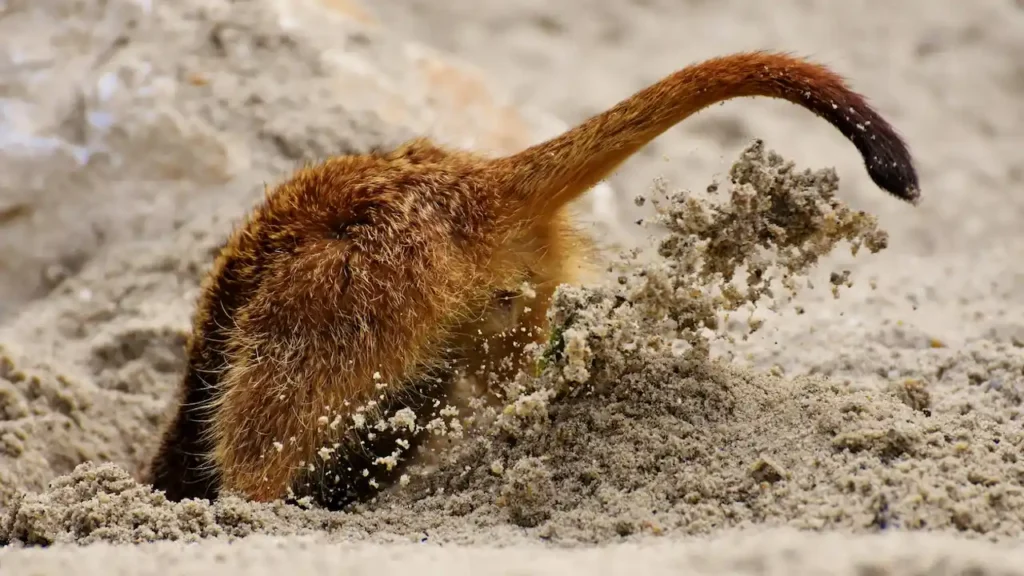Dogs have evolved alongside us. Many of their natural instincts remain deeply ingrained. One of these instincts is digging. This behavior can be both amusing and frustrating for pet owners. Some dogs seem to have an insatiable desire to dig.
But why do dogs love to dig? Let’s explore the reasons behind this behavior and what you can do about it.
Reasons of Dog Digging
Here’s the reasons why dog digs.
Instinctual Behavior
Digging is a deeply ingrained instinct for dogs. It has been tracing back to their wild ancestors.
Before domestication, dogs lived as opportunistic hunters and scavengers. They relied on their instincts to survive in challenging environments. One of the most critical survival skills was digging. This served multiple purposes.
In the wild, wolves would dig dens to provide shelter. These underground burrows offered warmth during cold winters, shade during scorching summers, and a safe space for raising their young.
For example, pregnant females would dig elaborate dens to give birth and nurse their pups in relative safety. This instinctual behavior remains encoded in the DNA of modern-day dogs.
Another key aspect of digging in the wild was food storage. They developed strategies to ensure they had access to resources when food was scarce.
One such strategy involved burying excess food. They stored bones, meat scraps, and entire carcasses in shallow holes. By covering their stash with dirt, they could protect it from scavengers and preserve it for later consumption.
This hoarding behavior has been passed down through generations. Today’s dogs exhibit similar tendencies by burying toys, treats, and stolen socks in the yard. To them, these items represent valuable possessions worth safeguarding.
Even though domesticated dogs now rely on humans for food and shelter, their evolutionary history continues to influence their actions. Digging isn’t just a random habit. It’s a reflection of their primal instincts to survive in the wild.
Breed-Specific Traits
Not all dogs dig equally. Certain breeds are more inclined to engage in this behavior. This is due to their genetic makeup and historical roles. Understanding your dog’s breed-specific traits can shed light on why they feel compelled to dig.
Terriers are perhaps the most notorious diggers among dog breeds. Originally bred to hunt vermin, terriers were specifically developed to pursue prey into underground tunnels. Their small size, tenacity, and strong forelimbs made them ideal for digging into dens and flushing out hidden animals.
Jack Russell Terriers, Cairn Terriers, and West Highland White Terriers still retain this instinctive drive to dig. Even without a rodent in sight, these dogs may channel their energy into excavating flowerbeds.
Beagles and Dachshunds also have a natural affinity for digging. These breeds were historically used to track game. Their keen sense of smell and determination make them persistent diggers. They could detect the scent of prey beneath the surface.
A Beagle might start digging furiously after catching a whiff of a mole, while a Dachshund might attempt to tunnel its way to an elusive critter.
Siberian Huskies and Alaskan Malamutes may dig for different reasons. These dogs originated in cold climates. During warmer months, they would dig into the ground to find cooler soil to lie on. Similarly, in frigid conditions, they might dig shallow pits to create insulated nests.
Each breed’s unique background contributes to its propensity for digging. If you own a dog from one of these groups, it’s important to recognize that their behavior is not mischievous. It is an expression of their innate nature.
Boredom and Excess Energy
Dogs are active animals. They require regular physical exercise. When these needs aren’t met, they turn to undesirable behaviors.
High-energy breeds are prone to digging. These dogs were originally bred for demanding jobs. Digging provides them physical exertion and a sense of accomplishment.
Loneliness also plays a role. If left alone for long stretches, they may dig as a way to cope with stress. In some cases, digging becomes a cry for attention. Even negative attention is better than none at all. For instance, a dog might dig near a fence to get closer to people passing by.
Provide your dog with plenty of enrichment opportunities. Interactive toys, agility training, and games help burn off excess energy. This keeps your pup mentally engaged.
Comfort and Temperature Regulation
Digging can sometimes serve a practical purpose. One common reason dogs dig is to regulate their body temperature.
On hot summer days, the surface layer of soil absorbs and retains heat from the sun. This makes it uncomfortable for dogs to lie directly on the ground. Dogs dig at the dirt to expose cooler layers underneath. This behavior allows them to create a makeshift cooling pad where they can rest comfortably.
You’ve probably noticed your dog sprawled out in freshly dug patches during sweltering weather—it’s their way of beating the heat!
Conversely, in colder climates, some dogs dig to insulate themselves against the chill. By hollowing out a shallow depression in the ground, they can curl up inside and trap their body heat. Breeds with thick coats are especially adept at using this technique.
This dual-purpose behavior highlights dogs’ remarkable ability to adapt to their environment.
Hunting Prey
Many dogs have heightened senses of smell and hearing. These allow them to detect the presence of underground critters. Once they pick up on these scents or sounds, their curiosity kicks in. This prompts them to investigate further by digging.
Breeds with strong hunting instinct are particularly likely to engage in this type of digging. For example, a Jack Russell Terrier might spend hours relentlessly digging in pursuit of a mole. Even non-hunting breeds may display this behavior if they encounter wildlife in the yard.
The problem arises when this behavior becomes obsessive.
Some dogs will dig repeatedly in the same spot. This creates massive holes and causes significant damage to gardens. If your dog frequently digs because of prey-related triggers, consider taking steps to minimize encounters with wildlife. Remove potential attractants. Install barriers around garden beds. Or use deterrent sprays to redirect your dog’s attention elsewhere.
Escape Attempts
Finally, digging can be a sign that your dog is attempting to escape confinement. There are several reasons why a dog might try to dig under a fence.
Curiosity might help your dog digging. Dogs are naturally curious. The world beyond their yard holds endless fascination. If they see or hear interesting sights and sounds outside their boundary, they may dig to explore further.
Loud noises, such as thunderstorms, fireworks, and construction work, can trigger fear responses in dogs. To flee what they perceive as danger. They may dig frantically to escape the yard.
Dogs are pack animals that crave companionship. If they feel lonely, they may attempt to dig their way to reunite with family members and other dogs.
Escape-related digging poses serious risks. It exposes dogs to hazards like traffic accidents, territorial conflicts with other animals, and getting lost.
To address this behavior, ensure your dog feels secure and content within its environment. Reinforce fences with buried barriers. Provide ample supervision during outdoor time. Address any underlying anxiety issues with professional guidance if necessary.
Managing Your Dog’s Digging Habit
Take proactive steps when digging becomes problematic. Problematic digging damages gardens and uproots plants. There are several effective strategies you can implement to manage and redirect your dog’s digging tendencies.

Provide Stimulation
Sometime dogs dig is due to boredom. Provide adequate physical exercise and mental engagement. Ensuring your dog has plenty of opportunities to burn off steam. Staying mentally sharp is key to preventing this issue.
Take your dog on regular walks. Border Collies, Australian Shepherds, and Retrievers require vigorous activity. Swimming, agility training, and playing fetch are excellent ways to wear them out.
Dogs need mental stimulation just as much as they need physical exercise. Interactive toys, puzzle feeders, and obedience training sessions keep their minds focused. Teaching new tricks provides mental challenges and strengthens the bond between you and your dog.
A well-exercised and mentally stimulated dog is far less likely to engage in digging. Because they’ll already have healthier outlets for their energy.
Create a Designated Digging Area
Some dogs love to dig. Trying to completely eliminate the behavior might be futile. Instead, consider creating a designated space where your dog is allowed to dig freely. This approach satisfies their natural urge to dig and protects your yard from damage.
Choose an area in your yard that’s easy to maintain and fill it with loose soil or sand. Make sure it’s large enough for your dog to move around comfortably. You can add borders made of wood to clearly define the space.
To entice your dog to use the designated digging zone, bury toys in the sand. Praise them enthusiastically whenever they dig in the correct spot. Over time, they’ll learn that this is the approved place to dig.
Discourage your dog to dig in forbidden areas. Gently guide them to the designated spot instead. With consistent redirection and positive reinforcement, they’ll begin associating the sandbox with fun and rewards.
Address Boredom
Dogs often dig out of boredom. It happens when left alone for long periods. Addressing these underlying emotional needs can significantly reduce unwanted digging.
Spend quality time with your dog every day. If you’re away from home frequently, consider hiring a dog walker. For anxious dogs, calming music, pheromone diffusers, or weighted blankets can help ease stress. Puzzle toys filled with treats or peanut butter can occupy their attention and distract them from digging.
Dogs that lack confidence may resort to digging as a coping mechanism. Engage in activities that build self-assurance. Positive reinforcement will boost their self-esteem.
Supervise Outdoor Time
Unsupervised outdoor time gives dogs ample opportunity to indulge in digging. Keep an eye on your dog. This allows you to intervene before they cause damage.
Watch for signs that they’re about to start digging. As soon as you notice these cues, step in and redirect their focus. Distract your dog with fun activities. Games help prevent digging.
Consider installing barriers. For example, chicken wire buried along the perimeter of flowerbeds can deter determined diggers. Supervision ensures that your dog remains engaged in positive behaviors.
Digging is a natural in dogs. Understanding the underlying motivations can help you address it effectively.




